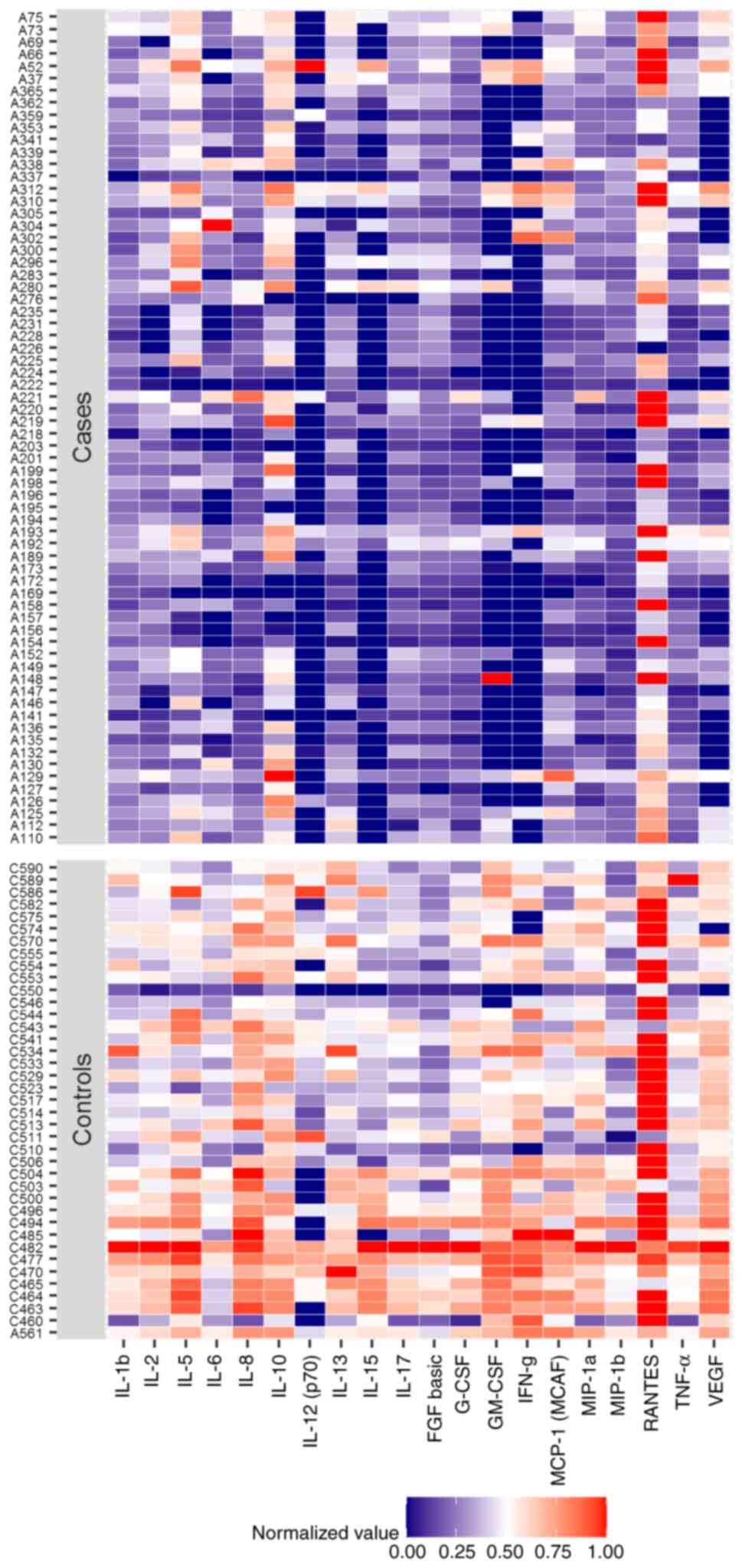|
1
|
Vaezi MF, Pandolfino JE, Yadlapati RH,
Greer KB and Kavitt RT: ACG clinical guidelines: Diagnosis and
management of achalasia. Am J Gastroenterol. 115:1393–1411.
2020.PubMed/NCBI View Article : Google Scholar
|
|
2
|
Boeckxstaens GE, Zaninotto G and Richter
JE: Achalasia. Lancet. 383:83–93. 2014.PubMed/NCBI View Article : Google Scholar
|
|
3
|
Gockel I, Becker J, Wouters MM, Niebisch
S, Gockel HR, Hess T, Ramonet D, Zimmermann J, Vigo AG, Trynka G,
et al: Common variants in the HLA-DQ region confer susceptibility
to idiopathic achalasia. Nat Genet. 46:901–904. 2014.PubMed/NCBI View
Article : Google Scholar
|
|
4
|
Boeckxstaens GE: Achalasia: Virus-induced
euthanasia of neurons? Am J Gastroenterol. 103:1610–1612.
2008.PubMed/NCBI View Article : Google Scholar
|
|
5
|
Latiano A, De Giorgio R, Volta U, Palmieri
O, Zagaria C, Stanghellini V, Barbara G, Mangia A, Andriulli A,
Corinaldesi R and Annese V: HLA and enteric antineuronal antibodies
in patients with achalasia. Neurogastroenterol. Motil. 18:520–525.
2006.PubMed/NCBI View Article : Google Scholar
|
|
6
|
Clark SB, Rice TW, Tubbs RR, Richter JE
and Goldblum JR: The nature of the myenteric infiltrate in
achalasia: An immunohistochemical analysis. Am J Surg Pathol.
24:1153–1158. 2000.PubMed/NCBI View Article : Google Scholar
|
|
7
|
Furuzawa-Carballeda J, Aguilar-León D,
Gamboa-Domínguez A, Valdovinos MA, Nuñez-Álvarez C,
Martín-del-Campo LA, Enríquez AB, Coss-Adame E, Svarch AE,
Flores-Nájera A, et al: Achalasia-an autoimmune inflammatory
disease: A cross-sectional study. J Immunol Res.
2015(729217)2015.PubMed/NCBI View Article : Google Scholar
|
|
8
|
Döhla M, Leichauer K, Gockel I, Niebisch
S, Thieme R, Lundell L, Schumacher J, Becker J, Rieker RJ, Hartmann
A, et al: Characterization of esophageal inflammation in patients
with achalasia. A Retrospective immunohistochemical study. Hum
Pathol. 85:228–234. 2019.PubMed/NCBI View Article : Google Scholar
|
|
9
|
Wang Z, Zhang J, Mi J, Ma H and Zhao D:
Expression and significance of interleukin-17 and interleukin-22 in
the serum and the lower esophageal sphincter of patients with
achalasia. Saudi J Gastroenterol. 24:242–248. 2018.PubMed/NCBI View Article : Google Scholar
|
|
10
|
Clayton S, Cauble E, Kumar A, Patil N,
Ledford D, Kolliputi N, Lopes-Virella MF, Castell D and Richter J:
Plasma levels of TNF-α, IL-6, IFN-γ, IL-12, IL-17, IL-22, and IL-23
in achalasia, eosinophilic esophagitis (EoE), and gastroesophageal
reflux disease (GERD). BMC Gastroenterol. 19(28)2019.PubMed/NCBI View Article : Google Scholar
|
|
11
|
Williams JR: The declaration of Helsinki
and public health. Bull World Health Organ. 86:650–652.
2008.PubMed/NCBI View Article : Google Scholar
|
|
12
|
Annese V, Basciani M, Perri F, Lombardi G,
Frusciante V, Simone P, Andriulli A and Vantrappen G: Controlled
trial of botulinum toxin injection vs. placebo and pneumatic
dilation in achalasia. Gastroenterology. 111:1418–1424.
1996.PubMed/NCBI View Article : Google Scholar
|
|
13
|
Richter JE: Modern management of
achalasia. Curr Treat Options Gastroenterol. 8:275–283.
2005.PubMed/NCBI View Article : Google Scholar
|
|
14
|
Eckardt VF, Aignherr C and Bernhard G:
Predictors of outcome in patients with achalasia treated by
pneumatic dilation. Gastroenterology. 103:1732–1738.
1992.PubMed/NCBI View Article : Google Scholar
|
|
15
|
International Conference on Harmonization
(ICH) Q2 (R1): Validation of Analytical Procedures-Test and
Methodology. 2005. Available from: https://database.ich.org/sites/default/files/Q2_R1_Guideline.pdf.
|
|
16
|
R Core Team (2012). R: A language and
environment for statistical computing. R Foundation for Statistical
Computing, Vienna, Austria. ISBN 3-900051-07-0, URL. Available
from: http://www.R-project.org/.
|
|
17
|
Park W and Vaezi MF: Etiology and
pathogenesis of achalasia: The current understanding. Am J
Gastroenterol. 100:1404–1414. 2005.PubMed/NCBI View Article : Google Scholar
|
|
18
|
Ghoshal UC, Daschakraborty SB and Singh R:
Pathogenesis of achalasia cardia. World J Gastroenterol.
18:3050–3057. 2012.PubMed/NCBI View Article : Google Scholar
|
|
19
|
Patel DA, Lappas BM and Vaezi MF: An
overview of achalasia and its subtypes. Gastroenterol Hepatol (NY).
13:411–421. 2017.PubMed/NCBI
|
|
20
|
Hurst SM, Stanisz AM, Sharkey KA and
Collins SM: Interleukin 1 beta-induced increase in substance P. in
rat myenteric plexus. Gastroenterology. 105:1754–1760.
1993.PubMed/NCBI View Article : Google Scholar
|
|
21
|
Hirota H, Kiyama H, Kishimoto T and Taga
T: Accelerated nerve regeneration in mice by upregulated expression
of interleukin (IL) 6 and IL-6 receptor after trauma. J Exp Med.
183:2627–2634. 1996.PubMed/NCBI View Article : Google Scholar
|
|
22
|
Takeda K and Akira S: Toll-like receptors
in innate immunity. Int Immunol. 17:1–14. 2005.PubMed/NCBI View Article : Google Scholar
|
|
23
|
Palmieri O, Mazza T, Merla A, Fusilli C,
Cuttitta A, Martino G, Latiano T, Corritore G, Bossa F, Palumbo O,
et al: Gene expression of muscular and neuronal pathways is
cooperatively dysregulated in patients with idiopathic achalasia.
Sci Rep. 6(31549)2016.PubMed/NCBI View Article : Google Scholar
|
|
24
|
Gockel I, Bohl JR, Doostkam S, Eckardt VF
and Junginger T: Spectrum of histopathologic findings in patients
with achalasia reflects different etiologies. J Gastroenterol
Hepatol. 21:727–733. 2006.PubMed/NCBI View Article : Google Scholar
|
|
25
|
Furuzawa-Carballeda J, Torres-Landa S,
Valdovinos MA, Coss-Adame E, Martín Del Campo LA and
Torres-Villalobos G: New insights into the pathophysiology of
achalasia and implications for future treatment. World J
Gastroenterol. 22:7892–7907. 2016.PubMed/NCBI View Article : Google Scholar
|
|
26
|
Kleiner G, Marcuzzi A, Zanin V, Monasta L
and Zauli G: Cytokine levels in the serum of healthy subjects.
Mediators Inflamm. 2013(434010)2013.PubMed/NCBI View Article : Google Scholar
|
|
27
|
Martinez-Fierro ML, Garza-Veloz I,
Rocha-Pizaña MR, Cardenas-Vargas E, Cid-Baez MA, Trejo-Vazquez F,
Flores-Morales V, Villela-Ramirez GA, Delgado-Enciso I,
Rodriguez-Sanchez IP and Ortiz-Castro Y: Serum cytokine, chemokine,
and growth factor profiles and their modulation in inflammatory
bowel disease. Medicine (Baltimore). 98(e17208)2019.PubMed/NCBI View Article : Google Scholar
|
|
28
|
Capone F, Guerriero E, Sorice A, Colonna
G, Ciliberto G and Costantini S: Serum cytokinome profile
evaluation: A tool to define new diagnostic and prognostic markers
of cancer using multiplexed bead-based immunoassays. Mediators
Inflamm. 2016(3064643)2016.PubMed/NCBI View Article : Google Scholar
|















